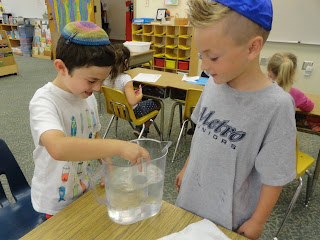Literacy in Primary is taught using flexible grouping to cater to the needs of each student. This helps ensure students are appropriately challenged while gaining independence.
Mrs. Boltz introduces these students to different literature doing read-alouds and shared reading activities. Integrating reading with other subjects is a great real-life application of reading. For instance, while the students were reading books about apples, Mrs. Boltz incorporated science by teaching them about the life cycle of an apple and the four seasons of an apple tree.
These students have been working so hard this year on learning their letter sounds and blending them to read and write words. Recently, they began using those sounds and sight words to write sentences about their own experiences!
"I went to my grandma's house."
For other students, Mrs. Boltz begins class with journal-writing time. This is about 5-10 minutes in which the students are encouraged to write about personal topics of their choice. This warm-up is great for fostering independence and getting their creative juices flowing.
Mrs. Boltz incorporates read-alouds and encourages discussion about different concepts and vocabulary from the reading. For instance, toward the beginning of the year, she read Wilfrid Gordon McDonald Partridge by Mem Fox and had students bring in their own memory items that were important to them. Not only did this help build community in the classroom, but this helped students realize that if they can remember things from their life, then they can write about them as well.
In smaller groups, she meets with students to read leveled books that are just beyond their independent level. She focuses on teaching reading strategies and CAFE (comprehension, accuracy, fluency, expand vocabulary).
While these groups are doing their guided reading with Mrs. Boltz, other students are working independently on literacy stations. Each week, they use a checklist to make sure they visit each station: read to self, read with a partner, listen to reading, word work, and work on writing.
Students also have the opportunity to use their iPads to access electronic books on an app called EPIC. The app allows students to read a story out loud, 

take turns reading a story out loud with a partner,
or listen to a story being read.
One of the many benefits of multi-age classes is the opportunity to teach and learn with peers.






















































